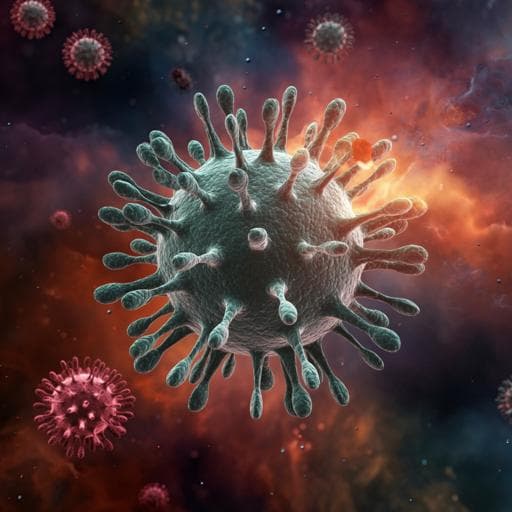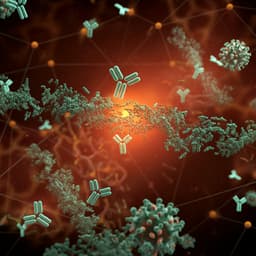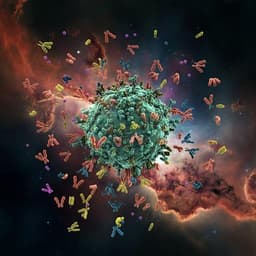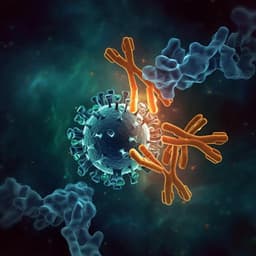
Medicine and Health
Discovery and characterization of potent pan-variant SARS-CoV-2 neutralizing antibodies from individuals with Omicron breakthrough infection
Y. Guo, G. Zhang, et al.
Discover groundbreaking insights into broadly neutralizing antibodies against SARS-CoV-2 variants, including Omicron, as unveiled by the research team led by Yu Guo and collaborators. This study explores the potential of rationally designed antibody cocktails, showing exceptional effectiveness against various variants, making strides toward promising therapeutic solutions.
~3 min • Beginner • English
Introduction
SARS-CoV-2 has caused a global pandemic with substantial morbidity and mortality while continuously evolving into variants of concern (VOCs) that undermine vaccine- and antibody-based interventions. Omicron, with extensive spike mutations including 15 in the RBD, exhibits pronounced immune evasion, especially from RBD-targeting antibodies, and has diversified into multiple sublineages (for example BA.1, BA.2, BA.4/5). Many approved monoclonal antibodies (mAbs) and cocktails have lost or reduced activity against these variants. Breakthrough infections after vaccination can elicit broader and more potent antibody responses than vaccination or infection alone, suggesting a promising source for discovering elite broadly neutralizing antibodies. This study aimed to isolate, characterize, and structurally define potent, pan-variant neutralizing antibodies from individuals with Omicron (BA.1) breakthrough infection and to rationally design noncompeting antibody cocktails with broad efficacy against emergent VOCs, including highly evasive lineages such as BQ.1.1 and XBB.
Literature Review
Prior studies demonstrated that Omicron sublineages escape many vaccine-elicited and therapeutic antibodies, with notable losses in efficacy for several authorized mAbs (e.g., LY-CoV555/LY-CoV016, REGN antibodies, and others). Immune imprinting (original antigenic sin) can bias responses toward ancestral epitopes, limiting breadth against newer variants. Nevertheless, breakthrough infections and boosters can expand antibody breadth and potency. Structural analyses across VOCs identified conserved RBD epitopes and constraints imposed by ACE2 binding and RBD folding that limit viable escape pathways; antibodies targeting such constrained sites tend to retain breadth. This work builds on these insights to mine breakthrough convalescent B-cell repertoires for elite neutralizers and to pair noncompeting antibodies to reduce escape.
Methodology
- Cohort: 38 Omicron-infected donors (mostly vaccinated with 2–3 doses of BBIBP-CorV; 4 unvaccinated). Peripheral blood mononuclear cells were isolated; RBD-specific (RBD+) B cells were enriched using biotinylated Omicron RBD and magnetic selection.
- Single-cell sequencing: 10x Genomics scRNA-seq and scBCR-seq performed on RBD+ B cells. In total, 277,630 B cells were profiled and mapped to the Atlas of Blood Cells; memory B cells (MBCs) identified by markers (e.g., CD27, GPR183). BCR contigs assembled (Cell Ranger VDJ); clonotypes defined by paired IGH/IGL(K) VDJ sequences. Somatic hypermutation (SHM) computed relative to germline (IMGT, IgBLAST). High-confidence clonotypes were filtered based on criteria including frequency >1, class-switched isotype (e.g., IGH1), SHM >2%, and containing at least one MBC.
- Antibody expression and screening: 386 mAbs expressed in HEK293 cells. Binding to WT and Omicron spike/RBD evaluated by ELISA. Blocking of ACE2–RBD interaction assessed by competitive ELISA across variants.
- Neutralization assays: Authentic SARS-CoV-2 WT, Delta, BA.1, BA.2 neutralization quantified (NT50). Pseudovirus neutralization tested for BA.2.12.1 and BA.4/5. A known potent nAb (XG347) served as positive control in some assays.
- Biophysics: Binding kinetics measured by SPR for representative mAbs against Omicron sublineage spikes/RBDs.
- Structural biology: Cryo-EM (3.3–3.8 Å overall) and X-ray crystallography determined structures of BA.4/5 spike (S) alone and in complexes with select Fabs (e.g., TH003, TH027, TH132, TH236, TH272, TH281) and cocktail combinations (TH027+TH132; TH272+TH281). Epitope mapping performed; interfaces analyzed (buried surface area, H-bonds, salt bridges, hydrophobic contacts).
- Cocktail design: 17 elite mAbs were assessed for noncompeting epitope pairing; six two-antibody cocktails were tested for breadth and potency across VOCs.
- In vivo efficacy: K18-hACE2 transgenic mice challenged intranasally with Omicron BA.5. Single-dose intraperitoneal administration (5 or 20 mg/kg) of TH027, TH132, or TH027+TH132 cocktail was given prophylactically (2 h before) or therapeutically (2 h post-infection). Outcomes: body weight, lung viral titers (qRT-PCR, plaque assays), histopathology, and immunofluorescence for viral antigen.
Key Findings
- Repertoire features: Vaccinated donors showed increased MBC frequency and numbers but lower SHM than unvaccinated donors. IGHV usage differed by vaccination status; IGHV2-5/IGHV3-23/IGHV1-69D and IGLV2-14/IGLV1-40 were frequently observed among high-confidence clonotypes. RBM-focused responses were often escaped by Omicron, whereas IGHV2-5–based clonotypes emerged as promising.
- Screening funnel: Of 286 tested mAbs, 119 bound WT S, Omicron S, and Omicron RBD; 44 blocked ACE2–RBD interaction across variants. Authentic-virus neutralization identified 19 elite mAbs with NT50 <150 ng/mL against BA.2; 14/19 showed broad neutralization across WT, Delta, BA.1, BA.2. Average neutralization potency against BA.1 and BA.2 was reduced 10.7-fold and 4-fold vs WT/Delta, respectively.
- Representative NT50 values (ng/mL): TH004 (WT 2.49; Delta 2.04; BA.1.1 2.46; BA.2 2.915), TH136 (5.67; 3.20; 0.96; 2.863), TH132 (6.15; 6.82; 8.07; 2.753), TH105 (6.00; 5.63; 6.31; 3.722), TH003 (27.61; 5.42; 14.77; 9.815), TH183 (17.46; 29.21; 70.24; 7.265), TH257 (19.45; 6.93; 5.79; 15.62), TH274 (47.73; 2.36; 1.80; 14.89).
- Affinity: 6/7 representative antibodies bound BA.2.12.1 and BA.4/5 spikes with KD in the 10^−9–10^−10 M range by SPR; TH048 lost binding to BA.4/5 and showed reduced neutralization specifically against BA.4/5.
- Structural basis: Cryo-EM structures (overall 3.4–3.7 Å; up to 3.3 Å local for RBD-up) revealed two main epitope communities: Group 1 (RBD outer face, ACE2 non-blocking; e.g., TH003, THZ7) often derived from IGHV2-5/IGHV3-23/IGHV3-1; Group 2 (ACE2 face, direct blockers; e.g., TH132/TH281) often derived from IGHV3-66/63. Interfaces featured extensive hydrophobic contacts and networks of H-bonds/salt bridges with conserved RBD residues (e.g., interactions around positions 439–446, 489–505). These epitopes are constrained by ACE2 binding and RBD folding, limiting escape.
- Breadth to emergent variants: TH132 retained high-affinity binding to BF.7, BQ.1.1, XBB, and XBB.1.5 spikes (KD ~10^−10 M) and maintained neutralization; TH027 lost binding/neutralization against some (e.g., BQ.1.1, XBB) but remained potent against BF.7.
- Cocktail synergy: Noncompeting pair TH027+TH132 showed enhanced breadth/potency. Example NT50 (ng/mL): BA.5 (TH027 1.830; TH132 0.819; cocktail 1.744), BF.7 (1.479; 5.578; 3.530), BQ.1.1 (18.92; 22.72; 7.731), XBB (13.62; 22.65; 5.390). Comparator LY-CoV1404 (bebtelovimab) was listed as <25 ng/mL for BQ.1.1 and XBB in this dataset. Cryo-EM of cocktails showed 2-up/1-down RBD conformations with both Fabs clamping up RBDs, tolerating key BA.4/5 escape mutations (e.g., L452R, F486V).
- In vivo efficacy: In K18-hACE2 mice infected with BA.5, a single dose of TH027+TH132 (5 or 20 mg/kg) given prophylactically or therapeutically improved body weight trajectories, significantly reduced lung viral loads at early time points vs vehicle, and markedly ameliorated lung pathology and viral antigen burden on histology/IF.
Discussion
This work demonstrates that BA.1 breakthrough infection in previously vaccinated individuals can yield elite monoclonal antibodies with broad and potent neutralization across SARS-CoV-2 variants, including immune-evasive Omicron sublineages. By deeply profiling the RBD-specific memory B-cell repertoire and prioritizing high-confidence clonotypes, the study uncovered germline biases (e.g., IGHV2-5, IGHV3-23, IGHV3-66/63) associated with breadth. Structural elucidation revealed conserved and functionally constrained RBD epitopes—some not directly overlapping the ACE2 interface yet conferring broad neutralization—explaining resilience to many Omicron substitutions. Guided by structural non-overlap and complementarity, rational antibody pairing (TH027+TH132) delivered enhanced breadth against highly evasive sublineages (BQ.1.1, XBB) and provided significant protection in vivo. These findings address the central challenge of neutralization escape by defining epitope/sequence features underpinning breadth and by proposing cocktail strategies that mitigate future escape under selection pressure, thereby informing next-generation therapeutic antibody development.
Conclusion
The study isolated and characterized dozens of potent pan-variant SARS-CoV-2 neutralizing antibodies from an Omicron (BA.1) breakthrough cohort, identified conserved structural epitopes supporting breadth, and designed noncompeting antibody cocktails with strong neutralization against diverse VOCs, including BA.5, BQ.1.1, and XBB. The TH027+TH132 cocktail demonstrated robust in vitro breadth and in vivo efficacy in a stringent mouse model. These insights highlight breakthrough convalescent repertoires as rich sources of elite antibodies and provide a structural blueprint for broad nAb and cocktail design. Future work should include clinical evaluation of lead antibodies/cocktails, continued surveillance of emergent variants for susceptibility, optimization of antibody engineering for half-life and effector function, and exploration of pan-sarbecovirus coverage.
Limitations
The abstract does not explicitly list limitations. Potential limitations include: (1) donor cohort size and geography (single-center, predominantly BBIBP-CorV–vaccinated), which may impact generalizability; (2) neutralization tested against a subset of VOCs/sublineages at the time—susceptibility of future variants remains uncertain; (3) in vivo efficacy assessed in K18-hACE2 mice, which may not fully recapitulate human disease; (4) some neutralization assays used pseudoviruses alongside authentic virus; (5) structural analyses centered on BA.4/5 spikes may not capture epitope dynamics in all emerging sublineages.
Related Publications
Explore these studies to deepen your understanding of the subject.







